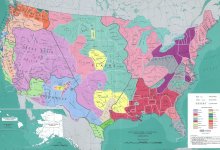Culturally Responsive Ways to Teach the History of Thanksgiving
These resources can help middle and high school students learn about the first Thanksgiving and Native Americans today.
Your content has been saved!
Go to My Saved Content.With Thanksgiving fast approaching, educators are grappling with how to teach their students about the first Thanksgiving in ways that honor the spirit of the holiday and are historically accurate and responsible.
The story that educators commonly tell of the first Thanksgiving is the same as what most Americans heard growing up. Pilgrims arrived in 1620 and had a tough winter. Native Americans, specifically the Wampanoag, helped teach them to plant hardy crops. After the successful harvest, they celebrated their friendship with a feast that came to be known as the first Thanksgiving. We tell this story because it’s easy to tell, although it doesn’t make for a richly engaging or solid history lesson.
When I first became a teacher, I knew my understanding of Native American history was limited, so I began the long but rewarding process of educating myself by reading articles written by Native voices sharing their perspectives on this national holiday and articles about Native American history. This initial research inspired me to keep asking questions and searching for culturally responsible ways of teaching middle and high school students about U.S. history. I hope you find these suggestions helpful as we enter into November, Native American Heritage Month.
Design lessons that include Native American knowledge
The Smithsonian’s National Museum of the American Indian (NMAI) invites us to rethink Thanksgiving celebrations and take care to not perpetuate stereotypes or misrepresent Native American traditions—complex traditions developed over thousands of years that are unique to each individual tribe.
Create lessons that include Native knowledge and celebrate the richness of Native cultures through Native American art, literature, and foods while celebrating Thanksgiving. The Smithsonian’s website offers a curated list of several culturally sensitive lesson plans, activities, and resources for educators.
These resources include a study guide for teachers exploring the factual context of the harvest ceremony and a teaching poster developed by NMAI that examines the deeper meaning of the Thanksgiving holiday for Native Americans through the themes of environment, community, encounters, and innovations.
discuss perspectives of Native Americans about Thanksgiving
In speaking about history, we may mistakenly send students the message that Native Americans exist only in the past. Moroni Benally, a citizen of the Diné Nation and public policy expert who has done much work with the Navajo Nation and Indigenous communities worldwide, shares his perspectives on how we can accurately and respectfully teach children about Native American people, Pilgrims, and the first Thanksgiving. Benally reminds us that by retelling and not correcting what he refers to as the “myths of Thanksgiving,” we are teaching children that Native American history and perspective don’t matter.
Although most Native Americans don’t live on reservations, some reservations have cultural centers that offer educational programs and materials for educators. Some programs include docent-led educational tours for students, hands-on activities, and exhibitions of Native American art and traditional crafts. A Google search for tribal centers and Native American museums in your area is a good place to start. Indigenous World, a nonprofit dedicated to connecting people to the unique arts, culture, ideas, and identities of Indigenous people today, also lists major Indigenous cultural organizations providing educational resources.
Research the history of the land you inhabit
Native Land Digital, an Indigenous-led Canadian not-for-profit organization, offers a digital map and Territory Acknowledgement guide. This digital map is a tool meant to create and foster conversations about the history of colonialism, Indigenous ways of knowing, and settler-Indigenous relations.
Access the map by entering an address or exploring the display of Indigenous territories (official and unofficial) worldwide. Click a location and various nation names come up, and you can learn more about the complex history of the land and each nation, language, or treaty associated with it.
Debunk the details
According to historians, commonly believed simple details about the famous Thanksgiving meal are not quite correct. A more accurate first Thanksgiving story, as Benally points out in his article, might entail the following. Celebrating their harvest, the Pilgrims shot guns and cannons. The Wampanoag responded by sending 90 warriors in response to the gunfire. The Wampanoag likely were not invited but simply crashed the feast. Culinary historians believe the meal included seafood.
Liz Kleinrock, an educator and recipient of the 2018 Teaching Tolerance Award for Excellence in Teaching, invites us to consider sharing how our understanding of history and perspectives have changed over time. History is not fixed—rather, it is constantly in a process of being refined.
After all, the subject of history (more aptly called social studies) is a study of people and relationships rather than a chronicle of events. And, thankfully, people change. According to Kleinrock, a crucial part of teaching history is modeling for students how our thinking can shift. For example, we can say, “I used to believe ____, but now I believe ____.” “I used to think ____, but now I ____.”
Through embracing this mindset, teaching about Thanksgiving can be an authentic, powerful learning moment for our students—and ourselves.

